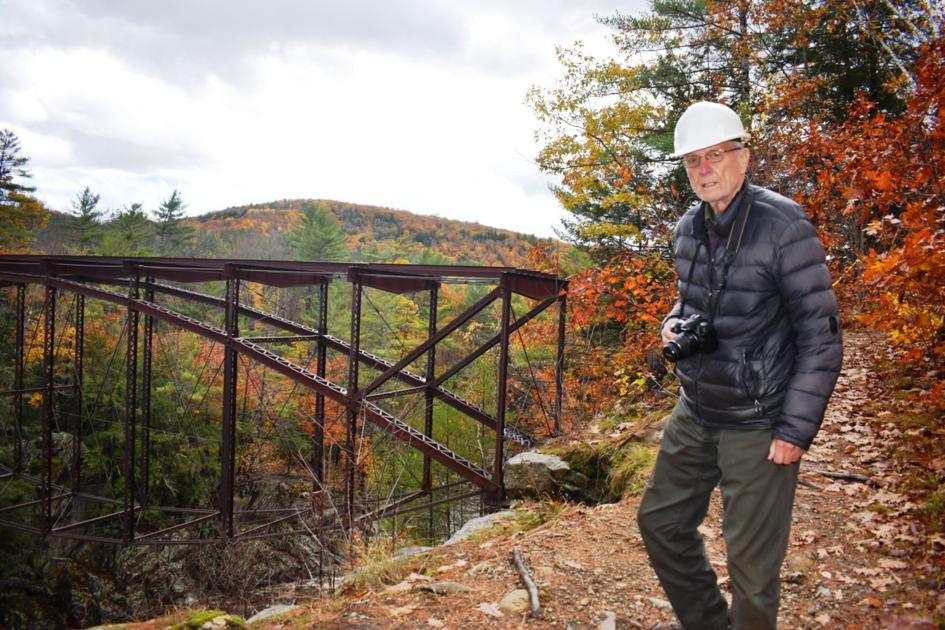
CAMPTON — While its ownership is unclear, what is certain — as echoed by some knowledgeable visitors — is that a former bridge over the Pemigewasset River could be an excellent viewing spot of what has been described as one of New Hampshire’s best publicly-accessible, geological formations.
Built in 1886 by the Berlin Iron Bridge Company of Berlin, Conn., but closed since 1959, the 263-foot long double-span bridge connected Holderness in the east and Campton in the west and carried pedestrians and motor vehicles between those communities and to mills in Livermore Gorge, said Malcom “Tink” Taylor.
The bridge — whose construction cost the towns of Plymouth, Campton and Holderness a cumulative $7,021 — has a distinctive “pumpkin seed” truss superstructure, which is below, not above the deck, said Taylor.
A member of the Holderness Historical Society, Taylor, 85, is a former state representative, state trooper, teacher, journalist and history buff.
In one or more capacities, Taylor has followed the fate of the Livermore Falls Gorge bridge since 1962 when a grant-funded team from the University of Connecticut came to Holderness to promote the creation of a walkable “townscape.”
The team, said Taylor, concluded the presentation of its findings with an observation about Livermore Falls, recommending it for protection as “a spectacular geological formation.”
In 1977, Taylor introduced House Bill 541, which was adopted and established a commission to study the acquisition of Livermore Falls Gorge; downstream, the state already owned 130 acres in the Livermore Falls State Forest.
Based in the state forest off Route 175 in Holderness, the Livermore Falls Recreation Area was extended by 40 acres in 1992 through the acquisition of what the NH Division of Parks and Recreation on its website called an area that “has a long history of industrial uses and contains ruins of a former pulp mill (1900), a salmon hatchery (1877) and popular recreation sites.”
Emphasizing the ambiguity of who has jurisdiction over it, the agency added that, “Adjacent to the site, but not owned by the state is a lenticular truss bridge …”
While the state doesn’t want to claim the bridge as its own, the U.S. Army Corps of Engineers might, said Taylor, as the bridge goes over a “navigable waterway.”
The Army Corps of Engineers is remaining quiet, he added, and on Sunday afternoon — when rainwater from downpours on Saturday and Sunday morning turned the Pemi into a fast-running torrent, it was difficult to think who, with the exception of expert kayakers, might be navigating the river.
The question of ownership, said Taylor, is a hindrance to anything happening with the bridge.
There have been efforts to get the bridge placed on the National Register of Historic Places — something that could be used to leverage grants and other funding sources, said Taylor — but the applications have failed because they never answered who owns the bridge.
The push to determine ownership, however, may have gotten a boost through a connection between Taylor and the Society for Industrial Archeology.
Formed in 1971 “to promote the study, appreciation, and preservation of the physical survivals of our industrial and technological past,” the SIA’s Northern New England Chapter, which is based in Elkins, a village in New London, had been reading what Taylor had been writing about the Livermore Falls bridge for a while.
Last December, David Dunning, the chapter’s president, called him, said Taylor, and two months later Dunning sent a glowing letter about the bridge to the Friends of the Pemi, Livermore Falls Chapter.
“That spectacularly-situated bridge high above the gorge has long been the subject of interest, drawing history buffs and engineering students from all over as well as being the subject of past meetings of our Society at Plymouth State University over the years. It has been studied, photographed and painted by many,” wrote Dunning.
He said his SIA chapter — which held its annual meeting on Oct. 16 in Plymouth and whose members that day received a tour of Livermore Falls Gorge courtesy of Taylor — supported efforts “not only to save this historic structure, the only one of its kind left in New Hampshire, and possibly in New England, but urge that provision be made for its safer viewing.”
Dunning suggested converting the bridge into “a safe public viewing deck as in similar parks around the nation” and on Sunday, Taylor said a great idea he had heard from audiences he’s spoken to about the bridge is to re-deck it with glass so that the public can see the river 103 feet below them.
The viewing spot would make Livermore Falls Gorge an even-more popular destination, said Taylor, on a par with the Quechee Gorge in Vermont, while the glass deck is evocative of the horse-shoe shaped cantilever Skywalk Bridge suspended over the Grand Canyon in Arizona.
With support from the SIA and others, Taylor is optimistic that something good will eventually happen to the Livermore Falls bridge and the area around it, although “there’s a question whether I might live to see it or not.”
"gorged" - Google News
November 01, 2021 at 04:46AM
https://ift.tt/3pVJzZd
New interest in the former 'pumpkinseed' bridge over Pemigewasset River in Livermore Falls Gorge - The Union Leader
"gorged" - Google News
https://ift.tt/2L9QNDn
https://ift.tt/2zlBS68
Bagikan Berita Ini

















0 Response to "New interest in the former 'pumpkinseed' bridge over Pemigewasset River in Livermore Falls Gorge - The Union Leader"
Post a Comment